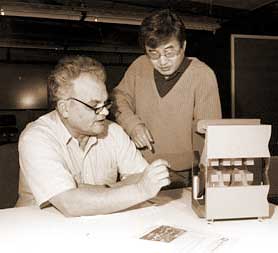|
Klaus Halbach, a Berkeley Lab physicist with the Engineering Division,
whose design and development of periodic permanent magnetic structures
called "insertion devices" opened the doors for the Advanced
Light Source and subsequent third-generation synchrotron radiation
facilities, died on May 11 at his home in Berkeley following a long battle
with prostate cancer. He was 75.
 |

KLAUS HALBACH SHOWN IN 1986 WITH KWAN-JE KIM DISCUSSING A MODEL
OF AN UNDULATOR HALBACH DESIGNED
|
In 1995, a "Halbach Symposium on Magnet Technology" held at
the ALS drew more than 100 participants from around the world. Two of the
principal organizers of that symposium were Berkeley Lab's Brian Kincaid
and Ross Schlueter.
"Klaus was instrumental in convincing me to leave Bell Labs in
1988 to come here to work on the ALS," said Kincaid. "In
addition to having a major influence on accelerator physics worldwide, he
was my friend, teacher and mentor for 18 years. I miss him."
Said Schlueter, "He exuded the enthusiasm of a little boy
continually making new discoveries, and he relived his excitement each
time he was able to bring a colleague to see the beauty and simplicity in
his world of the conformally-transformed plane where he habitually thought
and worked."
A native of Germany, Halbach received his Ph.D. in physics at the
University of Basel in Switzerland and came to the United States in 1957
to work at Stanford University with the great nuclear magnetic resonance
pioneer Felix Bloch. Following a short return to Switzerland to start a
plasma physics group, he joined the plasma physics group at Berkeley Lab
in 1960. His work in this field led him into accelerator design, and he
was a major contributor to the Omnitron, a proposed synchrotron that would
have accelerated nuclei of all 92 elements from hydrogen to uranium.
Although never built, the Omnitron's design laid the groundwork for the
Bevalac.
For all his success as an accelerator designer, Halbach is best known
for his later work on magnetic systems for particle accelerators. He and
Ron Holsinger, a Berkeley Lab engineer and later Halbach's son-in-law,
created the famous POISSON package of computer codes for magnetic system
design, still in use today. Halbach went on to become one of the world's
premier designers and developers of permanent magnets for use as insertion
devices -- wigglers and undulators -- in synchrotron light sources and
free electron lasers.
Unlike electromagnets, Halbach's permanent magnet -- steel hybrids
required neither expensive electrical power nor space-consuming coils to
produce powerful magnetic fields. Consequently, these magnets could be
made small enough to fit inside the tight confines of an electron storage
ring. Halbach also designed electromagnet dipole, quadrupole and sextupole
magnets to bend and focus the ALS storage ring beam.
As a world authority on the design of magnetic systems, Halbach was a
consultant to accelerator projects and synchrotron light sources around
the world, including the Advanced Photon Source at Argonne and the
Stanford Synchrotron Radiation Laboratory. All of the premier radiation
sources within these machines depend upon the permanent magnet technology
now known as the Halbach Array.
Although he officially retired from Berkeley Lab in 1991, Halbach
continued to work on magnet design and trained numerous students in his
field. He made contributions to such diverse projects as magnets for a
miniature cyclotron that could be used for medical radioisotope
production, magnets and low-friction magnetic bearings for an
electromechanical battery, and the design of miniature permanent magnet
NMR spectrometers for future Mars lander missions. The ALS now gives out
an annual award to recognize excellence in instrumentation design and
development called the Klaus Halbach Award.
Halbach is survived by his wife of 55 years, Ruth, daughter Terry, and
three grandchildren. A memorial service will be held on June 28 at 3 p.m.
in the Brazilian Room in Tilden Park. Contributions may be made to the
Kaiser Oakland Hospice Program, 280 West MacArthur Blvd, Oakland CA 94611,
510 596-6390. |


